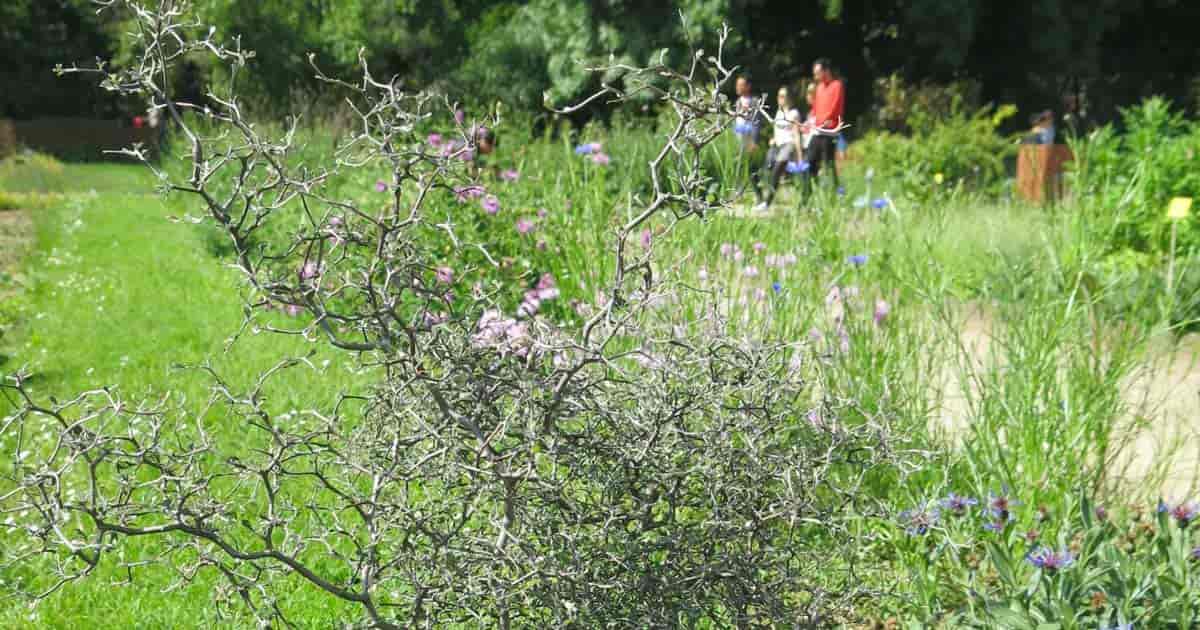Corokia cotoneaster [kor-ROH-kee-uh, kot-on-ee-ASS-ter] is a flowering plant species of the Rosaceae (rose family) native to New Zealand.
The genus name Cotoneaster derives from cotoneum, a Latin name for the quince, and the suffix -aster, ‘resembling’.

The plant features small, dark green colored leathery leaves and produces yellow or red berries.
Different colored berries can sometimes be produced from a single plant, which not only gives it a fascinating appearance but is also a remarkable uncommon property in the family.
From the coastal cliffs to sub-alpine scrubs, the plant has a wide natural distribution throughout New Zealand.
The plant was first described by Etienne Raoul, a French surgeon, and botanist who went to New Zealand in 1840 as part of the groups sent to assist in the French settlement of Akaroa.
Popular varieties include:
- Cotoneaster horizontalis (Rock cotoneaster)- straight branches, pink flowers.
- Bearberry cotoneaster
- Rockspray cotoneaster
- Cotoneaster apiculatus
- Cranberry cotoneaster
- Cotoneaster adpressus
- Cotoneaster divaricatus
- Cotoneaster salicifolius
Corokia Cotoneaster Care
Size & Growth
A wire-netting bush is a very easy-to-grow evergreen shrub with branches forming a herringbone pattern.
The plant typically grows to about 10’ feet, but it is a slow-growing plant and can take anywhere from 10 to 20 years to reach the maximum height.
Under ideal conditions, the plant is expected to live for up to 30 years.
The common name of the plant comes from the fact it forms a rounded mass of interlaced branches spreading to about 8’ feet.
The tangled arching branches, small green leaves, and downy felt are the plant’s natural defense against windy climatic conditions.
Flowering and Fragrance
The corokia cotoneaster plant produces small, star-shaped, white flower colors, fragrant flowers in the late spring often followed by bright red fruit, a small pome roughly ½ inch in diameter.
The flower appears terminally as well as in leaf axils, in small groups.
Fall colors are yellow and red with the Fall foliage color turning bronze-red.
Light & Temperature
This plant type thrives in full sun and partial shade; however, it needs to be sheltered from cold, dry winds and extremely cold temperatures.
Cotoneaster is not hardy and can only tolerate cold temperatures for a few days only.
To keep your corokia cotoneaster healthy, protect it from cold temperatures and make sure to keep it between 35° – 59° degrees Fahrenheit (2° C – 15° C) during the winter season.
Apply a thick mulch around the root to protect it from cold weather in winters.
USDA hardiness zone 5 – 7.
Watering and Feeding
Corokia cotoneaster can tolerate both moist and dry growing conditions; however, it cannot tolerate standing water.
High amounts of water can cause the roots of the wire-netting bush to rot, so it is advised to let the soil get 70-80% dry between waterings.
Reduce the water amount in winters.
However, be careful not to let the plant completely dry out as well.
When the plant is actively growing, use a standard liquid fertilizer once a month or granules or spikes 2 to 3 times a month to support and maintain the growth.
However, cotoneaster dammeri doesn’t need to be fed in the first year.
Soil & Transplanting
Be it sandy, chalky, or loamy, corokia cotoneaster can grow in a wide variety of soils.
It also doesn’t have specific pH requirements and can tolerate urban pollution to some extent.
However, the soil needs to be fertile and well-drained.
Cotoneaster should not be transplanted too often because of their small root system.
The adult plants should be transplanted only once in every 2 to 3 years.
However, the young plants often get transplanted in 1 to 2 years.
Transplantation is best done in the spring season.
Grooming and Maintenance
While this deciduous shrub doesn’t need much maintenance, you may need to prune it to restrict growth.
The plant belongs to the pruning group 8, which means it can tolerate hard pruning.
However, it should only be pruned after the end of the flowering season.
How to Propagate Wire-Netting Bush
Creeping cotoneaster plants are best propagated through wood cuttings.
If using green wood cuttings, root them in early summer, but wait till mid or late summer to root semi-ripe cuttings.
Use a mixture of sand and peat to ensure proper growth.
While the plants are also propagated through seeds, they take a long time to germinate.
This is why the plant cuttings are mostly used for propagation.
Corokia Pest or Diseases
Cotoneaster is a trouble-free plant and is not prone to any serious pest or disease other than one.
The main disease is fireblight, if the disease is common in your area, you may want to look for an alternative to cotoneasters.
Suggested Uses Corokia Shrubs
Cotoneaster is widely grown in New Zealand, its native range, as a garden plant.
The plant is grown and appreciated in landscapes mainly due to its unique appearance – the plant features a relatively fine texture, but less refined foliage.
The bright-yellow colored flowers and multi-colored fruits of the wire-netting bush look spectacular.
Also, the plant is low maintenance.
All these features make Crokoia a good choice for landscaping.
The plant is recommended to be used for the following landscape applications:
- General garden use
- Hedges or screening
- Mass planting
- Structural planting
- Woodland gardens
- Naturalizing
Cotoneaster is often used as a topiary but also makes a good ground cover for erosion control.
John Lyall, a bonsai artist, based in Auckland, has made some wonderful bonsai specimens of this species.
While no toxicity has been reported, no part of the plant is edible.